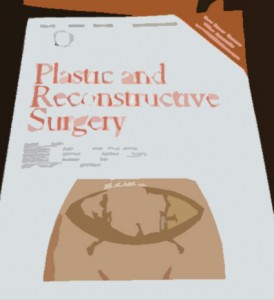I read our journal and constantly try to improve as a plastic surgeon. In the latest issue of Plastic and Reconstructive Surgery Journal from January 2012, there was an article, “Prosthesis Salvage in Breast Reconstruction Patients with Periprosthetic Infection and Exposure.” Wow. Quite a title.
In English what does this say? This study discusses how a breast implant which has become infected (red, warm, tender, fevers, pus), exposed (visible to your eye and the outside world), or both may be saved. This is a huge issue, as implants are foreign objects. If a breast implant gets infected, it usually has to come out. If the implant comes out, in the face of inflammation, scarring, and angriness, the pocket created for the implant may close, and you may never be able to reexpand the skin again. You then convert to a bigger operation (like a TRAM, latissimus, etc) or to fat grafting (if an option) or lose the reconstruction altogether.

So. Can you save these implants? Is there a group who can be saved? And if so, who are they?
This was a study out of the Departments of Plastic Surgery, Surgery, and Infectious Disease at the University of South Florida. They did a retrospective review of 60 patients who had attempted salvage between 2002 and 2008 by a single surgeon with a single protocol.
FINDINGS: Of the 60 patients, 17 had removal of the prosthesis without attempted salvage, in 43 attempted salvage was done. None of the patients had acellular dermal matrix.
They think their salvage rate is about 76%.
- Preop counseling is imperative.
- They changed their intraoperative course depending on what they found
- They excluded patients with severe infections (frank smelly pus or a thick inflammatory rind)
- Only one salvage attempt is done. (If the infection does not resolve after one try, then the infected implant is removed.)
- History of radiation therapy did NOT affect success rate
- Demographics of age, BMI, smoking were equal between salvaged and nonsalvaged group.
- Presenting symptoms of pain, fever, temperature, cellulitis did not correlate. WBC did not correlate either.
- Average time of implant to exposure/infection was within 6 months (they cite 14 months- but stated they think this number was skewed due to 2 outliers-most presented within 6 months).
- Once signs presented of infection or exposure, it took about 2-3 days until they were taken to surgery.
- Worse recovery was found in those with Staph Epi (other studies showed worse salvage with Staph Aureus and Gram negative rods, MRSA, and Candida)
- Their capsular contracture rate was 6%.
They conclude with saying “salvage breast tissue expander or implant reconstruction is a viable treatment modiality in cases of infection and/or exposure.” The surgery should be done quickly and aggressively, with surgery the same day as presentation and antibiotic coverage tailored to what is found intraoperatively if possible.
My thoughts?
I think salvage is appropriate to try when possible. I like the author’s algorithm. It can be devestating when these implants are lost. So again, I think it is worth a try.
